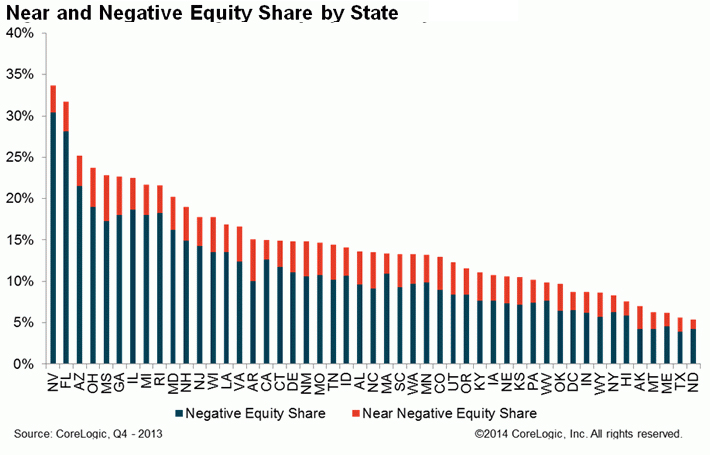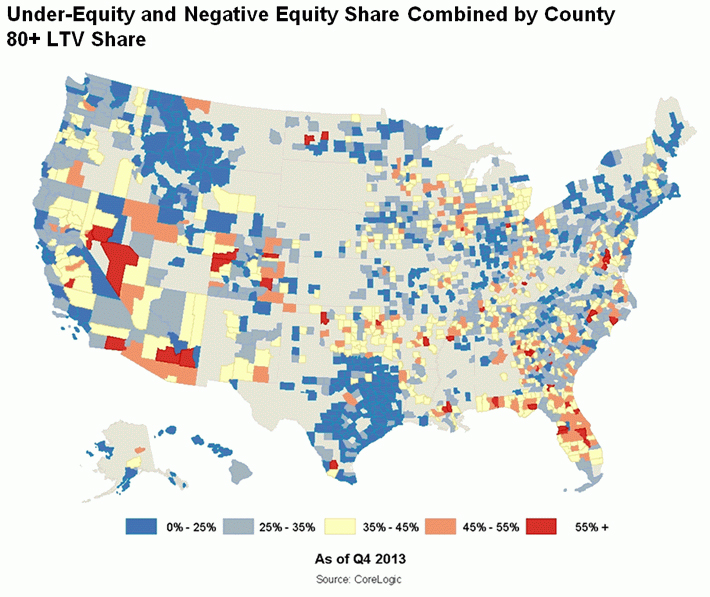The WPJ
THE WORLD PROPERTY JOURNALReal Estate Facts Not Fiction
Residential Real Estate News

Four Million U.S. Mortgaged Homes Gain Equity
Residential News » North America Residential News Edition | By Francys Vallecillo | March 6, 2014 10:03 AM ET
A total of four million U.S. homes returned to positive equity in 2013, bringing the total number of mortgaged residential properties with equity to 42.7 million, according to a report from CoreLogic.
Approximately 6.5 million homes, or 13.3 percent of all mortgaged homes, remained in negative equity at the end of 2013. Due to a small slowdown in the home price index growth rate, the negative equity share was little changed from the end of the third quarter. Negative equity -- referred to as "underwater" or "upside down" -- means borrowers owe more than their homes are worth.
"Only 14 states have a higher negative equity average than the U.S., and more states should experience improvement throughout 2014," said Anand Nallathambi, president and CEO of CoreLogic.
The national aggregate value of negative equity was $398.4 billion for the fourth quarter, compared to $401.3 billion the previous quarter, CoreLogic reports.
"The plight of the underwater borrower has improved dramatically since negative equity peaked in December 2009 when more than 12 million mortgaged homeowners were underwater," said Mark Fleming, chief economist for CoreLogic. "Over the past four years, more than 5.5 million homeowners have regained equity, reducing their risk of foreclosure and unlocking pent-up supply in the housing market."
A total of 10 million homes have less than 20 percent equity -- referred to as "under-equitied" -- and may have a difficult time obtaining new financing. In 2013, more than 1.6 million homes had less than five percent equity, which is considered near-negative equity and considered at risk if home price fall.
More from the report:
- Nevada had the highest percentage of mortgaged properties in negative equity at 30.4 percent, followed by Florida (28.1 percent), Arizona (21.5 percent), Ohio (19.0 percent) and Illinois (18.7 percent). These top five states combined account for 36.9 percent of negative equity in the United States.
- Of the 25 largest Core Based Statistical Areas (CBSAs) based on population, Orlando-Kissimmee-Sanford, Fla., had the highest percentage of mortgaged properties in negative equity at 31.5 percent, followed by Tampa-St. Petersburg-Clearwater, Fla. (30.4 percent), Phoenix-Mesa-Scottsdale, Ariz. (22.1 percent), Chicago-Naperville-Arlington Heights, Ill. (21.4 percent) and Atlanta-Sandy Springs-Roswell, Ga. (19.9 percent).
- Of the total $398 billion in negative equity, first liens without home equity loans accounted for $205 billion aggregate negative equity, while first liens with home equity loans accounted for $193 billion.
- Approximately 3.9 million upside-down borrowers hold first liens without home equity loans. The average mortgage balance for this group of borrowers is $219,000. The average underwater amount is $52,000.
- Approximately 2.6 million upside-down borrowers hold both first and second liens. The average mortgage balance for this group of borrowers is $293,000.The average underwater amount is $75,000.
- The bulk of home equity for mortgaged properties is concentrated at the high end of the housing market. For example, 92 percent of homes valued at greater than $200,000 have equity compared with 81 percent of homes valued at less than $200,000.


Sign Up Free | The WPJ Weekly Newsletter
Relevant real estate news.
Actionable market intelligence.
Right to your inbox every week.
Real Estate Listings Showcase
Related News Stories
Residential Real Estate Headlines
- U.S. New-Home Sales Surge in August as Mortgage Rates Ease
- Despite Increased Foreign Buyer Activity, Miami Residential Sales Dip 11 Percent in August
- California Home Sales Enjoy Modest Uptick as Mortgage Rates Ease
- U.S. Home-Flipping Profits Sink to Lowest Level Since 2008 Financial Crisis as Costs Climb
- Why the World's Rich Are Flocking to Europe in 2025
- Federal Reserve Delivers First Rate Cut of 2025 as Mortgage Relief Proves Limited
- Homebuilder Sentiment Holds Steady in U.S. as Rate-Cut Bets Lift Outlook
- U.S. Mortgage Rates Experience Sharpest Weekly Drop in Over a Year
- U.S. Foreclosures Rise for Sixth Straight Month as Affordability Pressures Mount
- Black U.S. Homeownership Rate Falls to Two-Year Low as Job Losses Mount
- Las Vegas Home Prices Flatten as Listings Surge, Sales Slow
- Cooling Miami Housing Market Sees 16 Percent Annual Sales Drop in July
- U.S. Mortgage Delinquencies Uptick in June Amid Regional Pressures
- California, Florida Top U.S. Housing Markets Most at Risk of Downturn
- 30-Year Mortgage Drops to 6.56 Percent in Late August, Lowest Since October 2024
- Investors Maintain Elevated Role in U.S. Housing Market Despite Slight Pullback
- Pending Home Sales Show Mixed Signals as U.S. Buyers Remain Cautious
- Canadian Home Sales Extend Recovery in July
- U.S. Home Sales Rise in July as Buyers Gain More Bargaining Power
- Zombie Foreclosures Edge Up Across U.S.
- 2.6 Million Homes at Wildfire Risk Across 14 Western States in 2025
- One in Five Americans Willing to Trade Personal Safety for Home Affordability
- U.S. Home Price Growth Slows as Affordability Pressures Mount in 2025
- U.S. Mortgage Rates Dip to Four Month Low in Early August
- U.S. Mortgage Applications Rise in Late July, Breaking Four-Week Slump
- Hong Kong's Housing Market Stuck in Stalemate as Bulls and Bears Face Off
- U.S. Condo Market Struggles in 2025
- U.S. Pending Home Sales Remain Sluggish in June
- Los Angeles Area Wildfires Destroyed Nearly $52 Billion in Homes Last January
- Greater Palm Beach Area Residential Sales Slip in June Amid Growing Inventory
- Economic Resilience Lifts U.S. Housing Outlook Going Forward
- New Home Sales Stagnate as Affordability Struggles Continue in America
- U.S. Housing Market Slips in June as Prices Hit New Highs
- Florida, California Continue to Reign Supreme as America's Ultraluxury Housing Markets
- Caribbean Housing Market Evolves into Global Second-Home Hotspot
- U.S. Home Sales See Highest June Cancellation Rate on Record
- Orlando Housing Market Cools in June as Listings Slide, Sales Slow
- Private Credit Surges in 2025 as Real Estate Developers Bypass Banks
- U.S. Condo Market Suffers Sharpest Price Drops in Over a Decade as Buyers Retreat
- Rising Taxes, Insurance Costs Undermine the Stability of U.S. Homeownership
Reader Poll
Marketplace Links
This website uses cookies to improve user experience. By using our website you consent in accordance with our Cookie Policy. Read More







